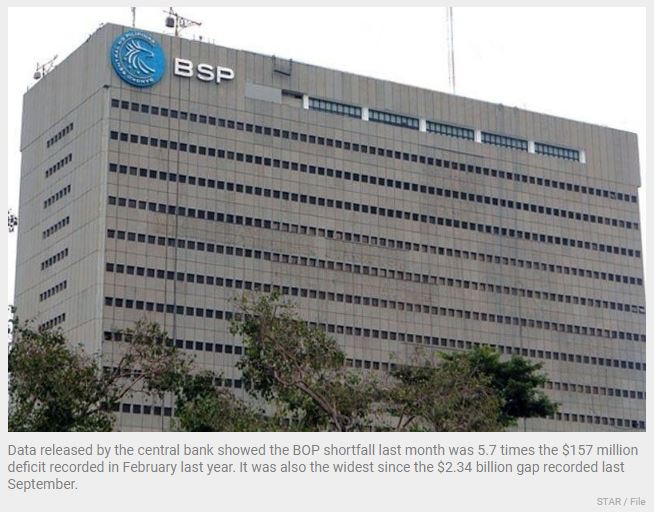Philippines: BOP gap widens to 5-month high
MANILA, Philippines — The Philippines registered a balance of payments (BOP) deficit of $895 million in February, the widest in five months, as the government settled more foreign obligations, the Bangko Sentral ng Pilipinas (BSP) said.
Data released by the central bank showed the BOP shortfall last month was 5.7 times the $157 million deficit recorded in February last year. It was also the widest since the $2.34 billion gap recorded last September.
“The BOP deficit in February 2023 reflected outflows arising mainly from the national government’s net foreign currency withdrawals from its deposits with the BSP to settle its foreign currency debt obligations and pay for its various expenditures,” the BSP said in a statement.
Notwithstanding the deficit in February, the cumulative BOP position remained at a surplus of $2.18 billion in the first two months of the year, reversing the $259 million deficit in the same period a year ago.
“Based on preliminary data, the cumulative BOP surplus reflected inflows that stemmed mainly from the global bond issuance of the national government in January 2023, personal remittances and foreign portfolio investments,” the central bank said.
Last January, the government tapped the international debt market for the second time since President Marcos assumed office in June last year.
The Philippines issued $3 billion worth of global bonds payable in 5.5, 10.5 and 25 years despite rising interest rates amid the aggressive rate hikes delivered by global central banks led by the US Federal Reserve.
The BOP is the difference in total values between payments into and out of the country over a time period.
A deficit means more dollars flowed out of the country to pay for the importation of more goods, services and capital than what flowed in from exports, remittances from overseas Filipino workers (OFWs), business process outsourcing (BPO) earnings and tourism receipts.
Rizal Commercial Banking Corp. chief economist Michael Ricafort said for the coming months, the BOP data could still be supported by the continued growth in the country’s structural US dollar inflows, such as OFW remittances, BPO revenues, exports, foreign investments (FDI) and foreign tourism receipts.
Ricafort also noted that the country’s first-ever A-credit rating by Japan Credit Ratings Agency (JCR) and the affirmation made by Moody’s Investors Service, Fitch Ratings and S&P Global Ratings of the investment grade rating of the Philippines are signs of resilience and improved international investor confidence.
“Thus, these reflect the Philippines’ improved economic and credit fundamentals, as well as improvements in fiscal performance in recent years, that could help attract more roster of international investments, both foreign portfolio investments and foreign direct investments and international loans at much lower cost and with better terms into the country,” he said.
The Philippines booked an all-time-high $7.26 billion BOP deficit last year, reversing the $1.35 billion surplus in 2021, as the elevated global commodity prices brought about by global geopolitical tensions further widened the gap between imports and exports.
The shortfall, however, was lower than the revised $11.2 billion shortfall or 2.8 percent of gross domestic product (GDP) projected by the central bank for 2022.
For this year, the BSP is now looking at a smaller BOP deficit at $1.6 billion or 0.4 percent of GDP from $5.4 billion or 1.3 percent of GDP. It is expected to further narrow to $500 million or 0.1 percent of GDP next year.
On the other hand, the central bank raised the projected gross international reserves level to $100 billion from $93 billion this year and to $102 billion in 2024.
Source: https://www.philstar.com/business/2023/03/22/2253382/bop-gap-widens-5-month-high


 Thailand
Thailand




